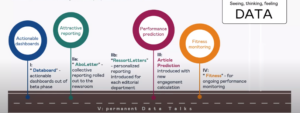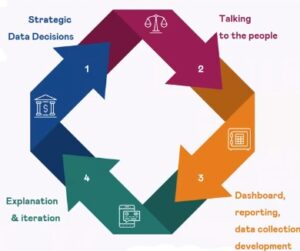

Behind this success is a strategy that aligns business and journalism, and unites all staff under the single goal of monetising quality journalism. This strategy evolved into a process that has helped drive them forward.
“How do we transition to become a more data-capable and digitally transformed company? Well, that only works step by step … One shouldn’t be fooled, it’s quite a steep stairway up towards digital transformation and growth only comes from a number of incremental steps,” said Stefan Körner, Chief Operating Officer, Die Presse, during WAN-IFRA’s recent Digital Media India virtual conference, elaborating on how Die Presse has built its data capabilities.
Building a robust data ecosystem
The team started off with building dashboards and analysing every aspect of their digital product. After some trial and error, the team fine-tuned the types of data they collected. Based on data analysis, action was recommended and executed on a day to day basis.
“We tried to build a data set up, a data ecosystem that really enables us to come to a state of seeing, thinking and feeling data,” said Körner. “All our dashboards and analytics tools have been developed closely with our editorial team, and they are made for a non-technical audience,” he added. Today, Die Presse’s analytics ecosystem comprises a few crucial elements as follows.

Actionable dashboards
Accessible 24×7 online, the focus of actionable dashboards is quick decision making for story positioning. It segments stories and users and does engagement scoring and conversion tracking. The granular-level segmentations include what non-subscribers are reading, what loyal non-subscribers are reading, what subscribers are reading, engagement scoring, conversion tracking and so on.
“What we learned from these dashboards was that they only work for real-time information and not for learnings and informed decision making for a broader and longer-term perspective,” said Körner.
This got the team to come up with the next element, Aboletter.
Aboletter: An internal collective reporting tool
Aboletter, or the internal subscription letter, is a collective reporting tool that reaches every journalist’s inbox regularly. Built in several iterations consulting the newsroom, Aboletter helps the team to easily identify outliers.
“Similar to what happens in journalism, we have a strong preference for humanly curated content. Aboletter is not generated by machines, but is curated by people,” Körner said.
People sit down, take a look at the data, see what can be learned from it and communicate it routinely on every Friday to every journalist in the company. According to Körner, the routine is particularly important as it was his learning that data tends to be neglected if there’s no routine.
Keeping staff focussed on KPIs
The Aboletter’s structure was improved over several iterations and was expanded to create a subdivision called Ressort Letters. Another department letter, Ressort lists the most important KPIs for every department, the most effective stories in terms of reach and engagement, the split between free and premium stories, most popular stories, best converting stories and so on.
“It clearly communicates our main KPIs, conversions and so on at department levels. It also makes important stories stand out and this then drives not only journalistic improvement but also product development,” Körner said.
“We now clearly understand which stories on which days in which department are good for reach, which are valuable for conversions. So now we can start learning from this data and start working on the whole value chain from the upper part where it’s mostly about getting reach, making people more loyal and getting them to subscribe to our products,” he added. Ressort letters, again, follow a routine and are delivered to the heads of departments every Monday.
Performance prediction tool
The team then came up with its performance prediction tool. Austria being a popular skiing nation, the tool was named “The ski jumper’s graph.” In Körner’s words, this was because ski jumpers and Die Presse stories seemed to have a lot in common.
“In skiing, you can jump far only if you have the perfect take-off and the right technique at the same time. Basically, this is what we try to do in our performance prediction. The graph shows story engagement and story openings. It allows us to see which story might be interesting to a bigger audience.” Körner explained.
The right usage of the graph could lead to quite a number of jackpot stories creating a win-win situation for all; the staff is more motivated as they see the numbers going up and from a business perspective a rising number of conversions could be achieved, says Körner.
Fitness monitoring
Another effective tool within Die Presse’s data ecosystem is the fitness monitoring tool. It is a dashboard where overall goals are set and tweaked on a month-to-month basis. Colour coding them helps to see how much has been achieved.
“This helped us not just to understand data, but it brought editors in chief and managing directors onto the same page when it comes to our KPIs and our data monitoring. This is now the perfect tool to measure our m-o-m or y-o-y performance in a single format that is understood, lived and accepted by the editorial team as well as the business team,” Körner said.
Data talks
While the tools and technologies have played a major role in building an effective data ecosystem at Die Presse, according to Körner, the most important part of its analytics system is the “data talks.”

“When I recruit data analysts I ask them what their biggest fear about the job is or what they disliked about their last job. Their answer is ‘their data not being used, ’” Körner said.
“Data has to come to its users. I tell my analysts they have to go to the stakeholders and talk to them directly and they have perfected this. This is the key and essence of how we built a data-friendly news organisation. Within this setup we built routines with different stakeholders – editors in chief, C-level management in the business department, regular editors and so on,” he added.
To sum it up, at the heart of Die Presse’s data ecosystem is a systematic process that includes making strategic data decisions, communicating it to the people, dashboard reporting, collecting data, working with it, explaining it and iterating. Körner concluded the session with three takeaways –
- Data will fail if it isn’t simple and lived throughout the company
- Data must be communicated permanently
- The data system must be an inclusive system.
Source: https://wan-ifra.org/2021/04/how-die-presse-built-its-data-capabilities-and-transitioned-to-a-data-friendly-news-organisation/
Image Credit: by Elizabeth Shilpa elizabeth.shilpa@wan-ifra.org

